Wudang Blog / Weapons
The Long Staff
The long staff can be called as the grandfather of all weapons. It is well known and practiced in many cultures, but has different names. In China it is called gun, in Japan – bo, in Korea – bong. Also, this will be one of the first weapons a student starts to practice in Shaolin Kung Fu, the same applies in Wudang Kung Fu.

In Wudang the Baxian Gun is one of the Wudang Mountain´s treasures, the Eight Immortal Staff was created by imitating the features of the Taoist Eight Immortals. Here the softness and flexibility are the most important features. Softness is often confused, especially by westerners, to mean weakness when it actually means power without a heavy exertion of force. Using your whole body to deliver a blow like in longfist, or using your center to throw the opponent like in taichi chuan, drunken embraces both aspects. Most in the western hemisphere do not understand this, kung fu is based on physics and practicality. To understand the power of these movements requires a noble heart, yet the practitioner who achieves these abilities reaches a level of understanding how to be effective in any combat scenario.
The Wudang Store Sword Guide
Our store is selling only hand forged swords which are forged by Masters in the Wudang region. Before buying the most important thing to consider is the purpose of the sword you want to buy. Depending on the purpose the maintenance, which is needed for the sword, can vary a lot.
This Guide is focusing on easy understanding and helping you to decide which kind of sword is for you.
Should I use a stiff or flexible blade?
 The balance of stiff blades is more on the head, while flexible blades tend to have the balance closer to the hilt. There are also semi flexible blades which still feel good in balance but wont bounce around as much as full flexible blades do. For Kung Fu performances you mostly want a flexible blade, since the power and stability of your movements can be measured and shown through your flexible blade. For Tai Chi you might want a semi flexible or stiff blade. With a stiff blade the fluid movements of Tai Chi feel very good and give you a stable sense of direction during your exercise.
The balance of stiff blades is more on the head, while flexible blades tend to have the balance closer to the hilt. There are also semi flexible blades which still feel good in balance but wont bounce around as much as full flexible blades do. For Kung Fu performances you mostly want a flexible blade, since the power and stability of your movements can be measured and shown through your flexible blade. For Tai Chi you might want a semi flexible or stiff blade. With a stiff blade the fluid movements of Tai Chi feel very good and give you a stable sense of direction during your exercise.
The most used types of steel for our swords
- Chrome steel, sometimes called stainless steel has a lot of chrome content which is protecting the sword against natural corrosion. Stainless steel is never 100% rust proof, but does have a higher rust resistance depending on the chrome content. More chrome means more resistance but also will make the steel softer and less durable. Stainless steel is NEVER made for cutting. The chrome steel shines with the small amount of maintenance time needed. To keep chrome steel healthy simply wipe it with a dry towel or cloth. Be sure to clean it from salty sweat or other acid containing substances after each practice. Chrome steel is fine for performances and daily training. You can identify chrome steel by its grey color and if the quality is high also mirror polishing is possible.
- Carbon Steel can vary a lot depending on tempering and quality. Sometimes it is the cheapest steel if the tempering is missing or the quality of the steel is not good. Our swords use normally the expensive high carbon steel. which is a more advanced version of the normal carbon steel and has slightly more carbon content. With more carbon content the steel will become harder, but at the same time the rust resistance is lower. To make up for this we always temper our high carbon steel blades and give them the proper polishing which is needed for a fine sword. With polishing the steel surface becomes small and so the area where rust can attack is smaller. This makes maintenance easier and more resistant to rust. If the maintenance comes to late and you find rust on your carbon blade, please go to a proper smith to let him polish it for you. If you try to polish the rust away yourself, you will ruin the tempering and polishing. Our traditional swords are polished in multiple layers and the tempering is the soul of every sword. We highly recommend to bring the sword to a proper smith if the blade is damaged or rusty. Our high carbon steel makes fine cutting swords. You can identify high carbon steel of its clear surface. Instead of grey color, the carbon steel looks white and shiny like a mirror. High carbon steel needs the most maintenance time, and should be maintained right after usage.
- Manganese Steel is the new technology and is mostly used in industry or heavy duty tools. Compared to high carbon steel, the manganese steel can be much cheaper with the same hardness properties. Manganese has more resistance to rust compared to carbon, but still needs proper maintenance. Manganese steel is hard enough to cut iron nails without being scratched. The properties of manganese steel are perfect for heavy duty cutting. Manganese steel is in most ways superior to carbon steel. Only the highest quality of high carbon steel and the finest forging could still be superior to a manganese blade.
What is the correct length for my sword?
If held in reverse grip at your side it should come to your ear. There is no must be when it comes to sword length. Usually if you like to leave a stronger impression in your performances, you might want a longer sword. But longer swords need more control and are usually slower in turning than shorter swords. Shorter swords are easier to balance. Longer swords need more attention in proper balancing. Wudang Store is making the job here for you, we check every sword before selling and the balance is always very good. Two handed swords have a proper length when they reach above your head. Single handed swords should not be longer than your head when held in reverse grip at your side.
What do i need for maintaining my blade?
If you have a chrome steel blade you dont have to worry much, only wipe once in a while after touching or training with a simple dry tissue or a piece of cloth.
These rules are important:
- Do not touch with fingers! On your skin is always some sweat or salty fat which is very aggressive to metal.
- Always put your sword back into the sheath, oxygen exposure will sooner or later make your blade rusty.
- Avoid salt, or other acid substances
- Cover your sword with this maintenance oil after usage.
- If this sword is not used, check the metal once a month and eventually reapply the oil
- Metal needs dry air, if you are living in tropical environments you have to check the blade more often.
For carbon or manganese steel blades please use our sword oil. The purpose of the sword oil is to prevent the oxygen to touch your blade. For the first time make sure you apply plenty of oil. Use a tissue or piece of cloth to apply the sword oil. Make sure you do not leave free spots on your blade. The steel should be covered in oil to prevent the touch of oxygen on the blade.
If the blade was expensive and made of high carbon steel be sure to coat the sword with oil right after usage. If the blade is still coated in oil, there is no need to reapply the oil. For manganese steel it is fine to check and apply oil once in a week or once in a month. This is strongly depending on how often you put the sword out of the sheath.
My blade is rusty! Can i fix it myself?
If the blade is made of chrome steel, then yes you can easily fix it with sandpaper. But if you do not fix it properly the blade will be rusty very fast again. This is because the sandpaper will scratch the surface and if not carefully polished, you will make the surface bigger and rust has a bigger area to attack the blade. The result is faster rusting and more often the use of sandpaper. When you intend to fix your blade from the rust be sure to use sandpaper with different stages. We recommend to use between 600 - 1000 grits for weak till medium corrosion. Polishing should be done in multiple steps starting with a 1000 grit paper and finish with 5000 grits. We do not recommend to use sandpaper on expensive swords or mirror polished blades. Please go to a professional smith.
I hope this clears most of your questions, if you have more please post a comment. We will put your question in this page for everyone to understand.
The Origin of the Crescent Moon Knives
 Crescent Moon Knives (Chinese: 鸳鸯钺; pinyin: Yuānyāngyuè), are Chinese bladed weapons consisting of two steel crescents crossing. They are used in Chinese martial arts. This crossing produces four curved, claw-like points, one of which is extended as the “main” blade. The practitioner grips the wrapped middle of the lengthened crescent with the other acting as a hand guard. Relatively short weapons that were easily concealable in traditional Chinese clothing, they are usually trained in pairs, one for each hand.
Crescent Moon Knives (Chinese: 鸳鸯钺; pinyin: Yuānyāngyuè), are Chinese bladed weapons consisting of two steel crescents crossing. They are used in Chinese martial arts. This crossing produces four curved, claw-like points, one of which is extended as the “main” blade. The practitioner grips the wrapped middle of the lengthened crescent with the other acting as a hand guard. Relatively short weapons that were easily concealable in traditional Chinese clothing, they are usually trained in pairs, one for each hand.
Crescent Moon Knives are especially associated with the soft style Chinese martial art Baguazhang, which is known for its diverse weaponry. They are mainly used in trapping an opponent’s weapon in aid of tying up or breaking the opponent’s weapon, disarming the opponent and other close combat applications.
 The Crescent Moon Knives are normally used against longer weapons such as spear, sword, broadsword, or any weapon which uses safe distances to attack from. One advantage of the Crescent Moon Knives in comparison to a longer weapon is that seeing as the deer horn knives are direct appendages of the hands, they can be moved with great speed and precision, and along with their ease of concealment, can easily be used to catch their opponent off guard.
The Crescent Moon Knives are normally used against longer weapons such as spear, sword, broadsword, or any weapon which uses safe distances to attack from. One advantage of the Crescent Moon Knives in comparison to a longer weapon is that seeing as the deer horn knives are direct appendages of the hands, they can be moved with great speed and precision, and along with their ease of concealment, can easily be used to catch their opponent off guard.
Some variations of the Crescent Moon Knives include pairs with one crescent being longer than the other, the large blade presumably being used as the “main” hand and the smaller blade as the “guard” hand.
Wudang Store selected Bagua Moon Knives of highest quality here.
The Monk Spade (or Fangbian Chan) a Buddhist and Taoist Weapon
The origin of the Monk Spade
A monk’s spade (Traditional Chinese: 月牙鏟; Simplified Chinese: 月牙铲; pinyin: yuèyáchǎn; literally “Crescent Moon Spade”; also, Traditional Chinese: 禪仗; Simplified Chinese: 禅仗; pinyin: chánzhàng; literally, “Zen Weapon”. Romanized Japanese: getsugasan, Hiragana: げつがさん), also called a Shaolin Spade, is a Chinese pole weapon consisting of a long pole with a flat spade-like blade on one end and a smaller crescent shaped blade on the other. In old China, Buddhist monks often carried spades (shovels) with them when travelling. This served two purposes: if they came upon a corpse on the road, they could properly bury it with Buddhist rites, and the large implement could serve as a weapon for defense against bandits. Over time, they were stylised into the monk’s spade weapon.
The Monk Spade as Taoist weapon
The Fangbian Chan (or Monk Spade) is an unusual kind of weapon, which also Taoists possess and wandering Taoists bring with them in their travels. It is said that the Fangbian Chan is Laozi’s creation. In the field of Daoist studies, practicing the Fangbian Chan not only demands rigor, but it also builds rigor. The Fangbian Chan is divided into 3 parts.
First, the head of the shovel: its length of 1.8 feet represents the secret space between the 18 levels of Hades. The shovel face’s 2 curved edges each have a ring, which represents the 2 energies of Yin and Yang. The neck of the shovel head has 5 iron rings, representing the 5 elements (fire, wood, water, metal, earth). So the idea of the 5 elements is that practicing the Dao to keep Yin and Yang balanced in order to have the power to break away from the abyss of misery, and suppress the 18 levels of Hades with the shovel.
Second, the handle of the shovel: its length of 3.3 feet represents the middle 33 heavens. The idea is to manage cause and effect, good and bad oneself.
Third, the end of the shovel: its length of 8.6 inches represents the 8 directions and 6 sides because the 3 curves of the drill it forms brings about conformation and represent 3 Cai (Heaven/Earth/Humanity). In addition, each curve has a loop representing 3 treasures (Jjing/Qi/Shen). In this way, there is Heaven and Earth, and people have life from the 3 heavenly treasures. For this reason, people who go out into the world and experience life must follow the natural way of the existence in this world and universe. Laozi created the Fangbian Chan form with 81 movements; the original idea was to remind his disciples to always keep Yin and Yang, always practice with the heart, body, and mind, and help others along the way. Keep doing this again and again throughout your life and you can become immortal in the end. After this, you can suppress the force of Hades and rise to the Heavens.
The Fangbian Chan is a complete weapon. It can be used as a staff, spear, long broadsword, and trident. It can be used to hook, hitch, chop, block, thrust, shovel, sweep, smack, beat, twist, etc. These applications are used to understand the principles of defending and attacking, backwards and forwards, slow and fast, hard and soft, etc. Here is the path to the product list with Monk Spades
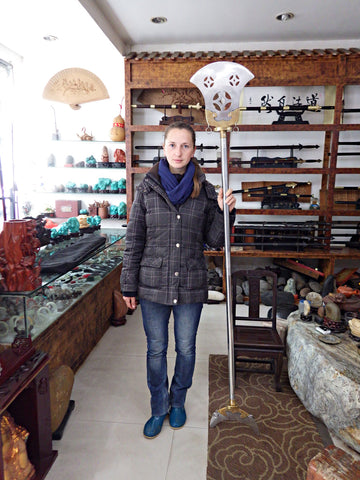
The Origin of the Double Hook Sword
 The hook sword, twin hooks, fu tao or shuang gou also known as hu tou gou (tiger head hook) is a Chinese weapon traditionally associated with northern styles of Chinese martial arts and Wushu weapons routines, but now often practiced by southern styles as well.
The hook sword, twin hooks, fu tao or shuang gou also known as hu tou gou (tiger head hook) is a Chinese weapon traditionally associated with northern styles of Chinese martial arts and Wushu weapons routines, but now often practiced by southern styles as well.
Reliable information on hook swords is difficult to come by. While sometimes called an ancient weapon and described as dating from the Song dynasty to Warring States or even earlier, most antique examples and artistic depictions are from the late Qing era or later, suggesting that they are actually a comparatively recent design. They were also an exclusively civilian weapon, appearing in none of the official listings of Chinese armaments. Surviving sharpened examples point to actual use as weapons, but their rarity, and the training necessary to use them, strongly suggest that they were only rarely used as such.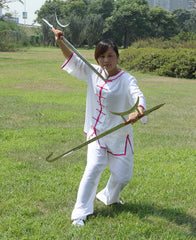 Also known as "tiger hook swords" or qian kun ri yue dao (literally "Heaven and Earth, Sun and Moon sword"), these weapons have a blade similar to that of the jian, though possibly thicker or unsharpened, with a prong or hook (similar to a shepherd's crook) near the tip. Guards are substantial, in the style of butterfly swords. Often used in pairs, the hooks of the weapons may be used to trap or deflect other weapons.
Also known as "tiger hook swords" or qian kun ri yue dao (literally "Heaven and Earth, Sun and Moon sword"), these weapons have a blade similar to that of the jian, though possibly thicker or unsharpened, with a prong or hook (similar to a shepherd's crook) near the tip. Guards are substantial, in the style of butterfly swords. Often used in pairs, the hooks of the weapons may be used to trap or deflect other weapons.
There are five components to the Twin Hook Sword:
- The back, which is used as a regular sword.
- The hook, which is used to trip enemies, catch weapons and for slashing.
- The end of the hilt, which is sharpened.
- The crescent guard, which is used for blocking and slashing.
- The link, which is used when using a pair. The two hooks can loosely connect, and the wielder swings one hook sword, in a way that the second is extended further out, almost six feet. While the second is in the air, the dagger upon the hilt slashes the target. In this way, the wielder can extend their reach out from three feet to six.
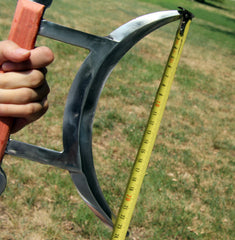 Routines for hook swords are taught in such northern schools as Northern Shaolin and Seven-Star Mantis, and in some schools of southern arts such as Choy Lay Fut. Modern routines for hook swords are often very flashy, and may involve techniques such as linking paired weapons and wielding them as a single long, flexible weapon. Most routines are single person. Some schools of Baguazhang also teach a similar weapon, often called "deer horn knives" or "Mandarin duck knives." These weapons typically feature a much shorter or entirely missing main hook, and instead focus on the various cutting and stabbing blades arranged around the guard. Because of the various protrusions and the high possibility for accidental hooking or stabbing, they are almost never used in sparring, and are used sparingly in two person routines. Check out our Double Hook Swords Selection at the Wudang Store.
Routines for hook swords are taught in such northern schools as Northern Shaolin and Seven-Star Mantis, and in some schools of southern arts such as Choy Lay Fut. Modern routines for hook swords are often very flashy, and may involve techniques such as linking paired weapons and wielding them as a single long, flexible weapon. Most routines are single person. Some schools of Baguazhang also teach a similar weapon, often called "deer horn knives" or "Mandarin duck knives." These weapons typically feature a much shorter or entirely missing main hook, and instead focus on the various cutting and stabbing blades arranged around the guard. Because of the various protrusions and the high possibility for accidental hooking or stabbing, they are almost never used in sparring, and are used sparingly in two person routines. Check out our Double Hook Swords Selection at the Wudang Store.
The Wudang Fuchen - Horsetail Whisk
Fu Chen is a soft weapon originally used by Taoists for their travels designed to whisk away flies and mosquitos. Later generations have created the Fuchen form performed with a Horsehair Whisk.
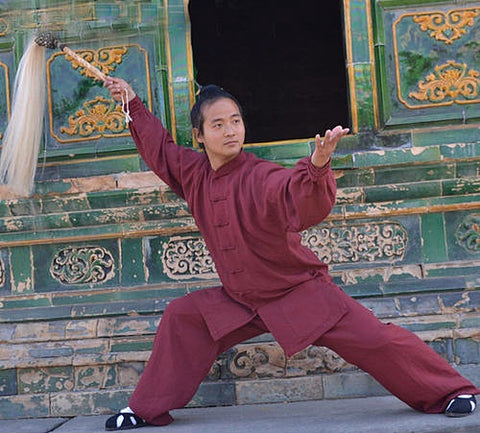
The use of the Fuchen as a martial arts weapon was popularized by the Wudang Daoist Monks. They brought the whisk to its current level of notoriety especially given that many lay people believed it to be the only thing the Wandering Monks had available to protect themselves while out on their pilgrimage for acceptance by their masters. In actual fact, one of the other things the Wandering Monks were given when leaving the temple was a sword, so it can safely be assumed they would have used both weapons for self-defense if required. Wudang Fuchen is a weapon that truly combines the Yin and the Yang, with a hard handle and a soft tail. A weapon that on its shaft has one end rounded and the other end mounted with a conical metal tip hidden under its tail.

The movements of this form are made up of dusting, sweeping and picking. This weapon looks very soft and gentle but is extremely hard and strong for the opponent. The Horsehair Whisk or Fuchen is a special Taoist weapon. There is a saying: “The person who holds the Fuchen is not an ordinary person.” In Taoism, the Fuchen is for those who want to study seriously.
The Fuchen is essentially a whisk made by binding the hair from a horse’s tail to a long wooden handle. Throughout Chinese history the Fuchen has come in many guises from being as simple as palm fibers bound to Smilax root, through to the use of a variety of animal hairs including Yak, being bound with hemp onto a wooden shaft. The most luxurious and expensive were of course the whisks combining unusually colored horse hair with handles made from things such as Cinnabar, Ivory, Mahogany, Sandalwood and Ebony.
A long time ago, the Taoist temple was very serious in finding students. Usually, the Taoist master takes a long period of time to test and observe a disciple, after which the master will especially choose him for deeper teachings. Usually, a disciple will do simple work in the first three years, and learn some basic skills about Tao and kung fu, during which time, the master is still testing and observing the disciple’s patience. After 3 years of testing is complete, the master throws a ceremony to show his acceptance of a real disciple. Then the master allows the disciple leave to travel and study more, but he is worried the disciple will be tempted by many things and will not return. Therefore, before the disciple leaves, the master gives him a few things to remind him. One of these things: 1. a red belt (3.3 feet means to tame the mind) for this time period, he has to be serious and keep his mind at peace. 2. the Fu Chen, during his travels, befriend good people and help others. If he is enamored with something and is tempted to return to society, he must whisk away these ideas, like the Fu Chen. 3. the sword. If he has lost his way and has lost himself, the disciple remembers that his master has given him the sword to cut away these ideas, so that he may continue on his path. After 3 years of traveling and studying, he returns and the master sees that he has enough patience and steadfastness to live a lifetime at the temple, to learn the Dao, and finally for the master to teach him how to be immortal.
The Fuchen style is one of the soft weapon styles. wrapping and pulling, snapping, whisking, poking, sweeping, etc. It can be used like the broadsword, straight sword, scourge, and dart weapons. When you practice the Fuchen, your movements must be in tune with your intention, your intention must be in tune with your Qi, and your Qi must be in tune with your Shen. Its movements are smooth like the wind and flowing like water.

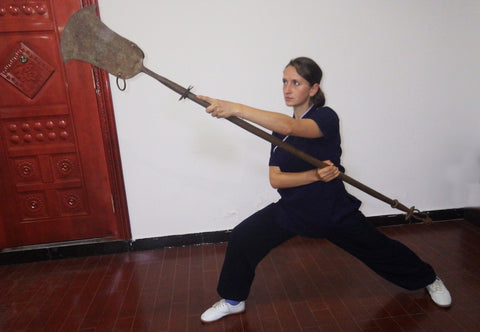
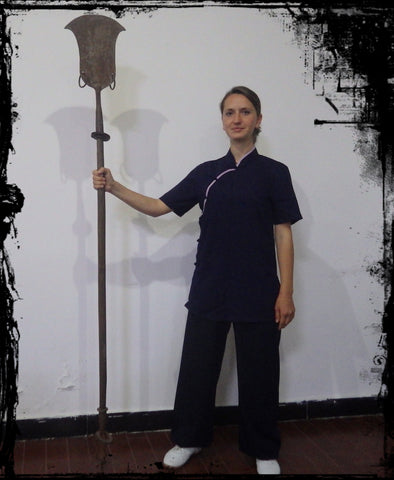
 Nothing will be posted on your behalf.
Nothing will be posted on your behalf.

